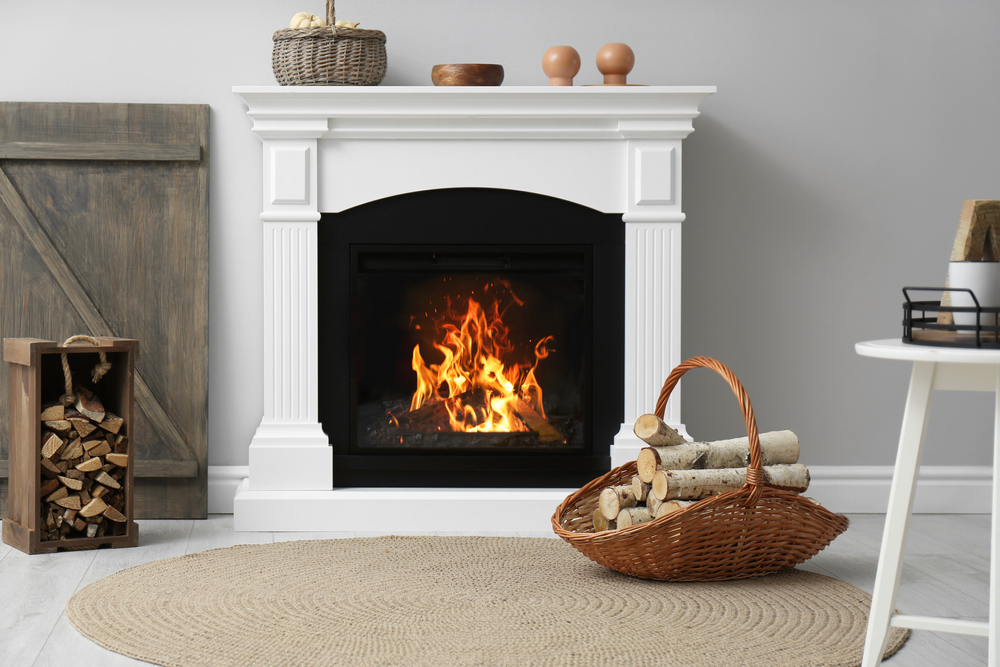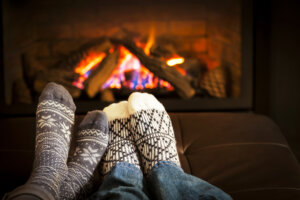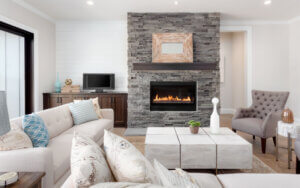As we descend into the short days of winter, thoughts turn to creating cozy spaces in the home. The Danish call it Hygge. Hygge cannot be translated as a word, rather it is a feeling. It’s the feeling you get when you spend a winter evening at a friends place, laughing, eating, drinking in a cozy atmosphere by the fireplace, with a few candles. Feeling loved and nurtured, protected. Happily cozy.
A big part of Hygge is the soft lighting of candles, or even better, the warmth and ever-changing beauty of a fireplace. Today’s consumer has so many more choices for fireplaces than ever before; even families who live in condominiums can enjoy the soft glow of a faux fire. Here are the different options available to you, depending on your needs.
Wood burning
Wood fireplaces remain the most traditional way to heat a home, and to create a beautiful atmosphere during the short winter days and long winter evenings. Wood is the least effective however, as about 80% of the heat created by the fire is sucked up through the flue. This is because the draft that must be created to vent the smoke from the home in fact also carries the heat out of the home.
Wood-burning fireplaces require regular maintenance and upkeep, or they can become dangerous. It’s critical to clean a chimney regularly to prevent creosote from building and creating serious a fire hazard. Along with chimney fires, wood-burning fireplaces can produce popping embers, rolling logs and other hazards that can cause fires if not properly protected against.
A serious disadvantage of a wood-burning fireplace is the harmful smoke and emissions it produces, indoors and out. It is a major contributor to particulate pollution in urban areas and poses serious health risks. For this reason many cities across Canada are placing restrictions or bans on wood-burning fireplaces and stoves; therefore many people are converting their wood-burning fireplaces into gas. Be careful to educate yourself about your municipal bylaws if you’re looking to incorporate a new fireplace or wood-burning stove into your home.
Burning wood also requires someone to buy and pile the wood in a dry place, and to stoke the fire. All of this is quite a bit of work, and purchasing wood is an extra cost that must be budgeted for. If you don’t enjoy playing with fire, want to minimize extra expenses, work and yet maximize your comfort, another option might be better for you.
Gas
A vented gas fireplace is comprised of a firebox, a chimney or vent, a gas line run to the unit and an electrical connection for some models. Direct vent gas fireplaces are 75-80% efficient and can be used as an effective heating source. Most gas fireplaces include a variable-setting control or thermostat that gives you the freedom to adjust the amount of heat coming out of your fireplace as well as a multi-speed fireplace fan.
Installation of gas fireplaces is fairly complex. Venting, running of gas lines and electrical connections involve considerable time, labor and planning by trade professionals. As with wood fireplaces, chimneys and gas lines need to be regularly inspected and maintained for safe usage and to eliminate the risk of fire.
Gas fireplaces can emit an odour, so those that are sensitive to odours or fumes may want to consider another option. Additionally, because gas fireplaces require a gas line and a way to exhaust to the exterior, they are often not a viable solution for condominiums.
Electric
Plug and play! There’s really not much easier than an electric fireplace. No need for a chimney, venting or anything other than figuring out where to put your new fireplace and pushing the “on” button. Electric fireplaces are also extremely economical compared to other solutions and can provide a cost-effective, supplemental heating solution.
Since they burn neither wood nor gas, electric fireplaces produce no smoke or fumes and are perfectly safe for any kind of living situation where there is electricity. There is no chimney to clean. You don’t have to buy, chop or stack wood. You never have to worry about cleaning up the logs or ash. The glass of an electric fireplace typically does not get hot, so is safe for families with small children.
Many people however, prefer to have a real flame, which an electric fireplace cannot provide.
Ethanol
Ethanol is a great solution if you are not able to vent a fire, but still want the look and heat of a real fire.
Ethanol fireplaces are super simple to install because they require no vent even though they do burn a real flame. This is because this kind of fireplace burns bioethanol, a clean-burning gas that emits water, heat and an insignificant amount of Carbon Dioxide. Be sure you research the manufacturing of the fireplace you purchase, and enquire as to whether or not the product is tested and certified.
Additionally, an ethanol fireplace loses no heat due to the lack of a flue. An ethanol fireplace usually produces around 2-3 kW, which is the equivalent of a radiator on full effect. Be careful however, as without a vent, you need some way to get a bit of fresh air into a room burning ethanol, as it does consume oxygen. If you can’t get fresh air into the room directly, it’s probably not wise to use the ethanol fireplace for more than an hour or so.
Even more fun, ethanol fireplaces often come in super cool, modern designs that are often mobile and are tailor-made for the condo crowd.
Whatever your desire, when you need to find someone to install or update your fireplace, start on HomeStars. Please consider writing a review when your project is complete, it helps the whole community!


